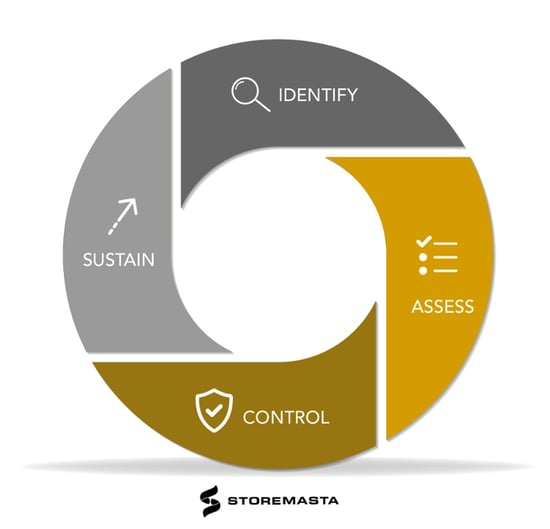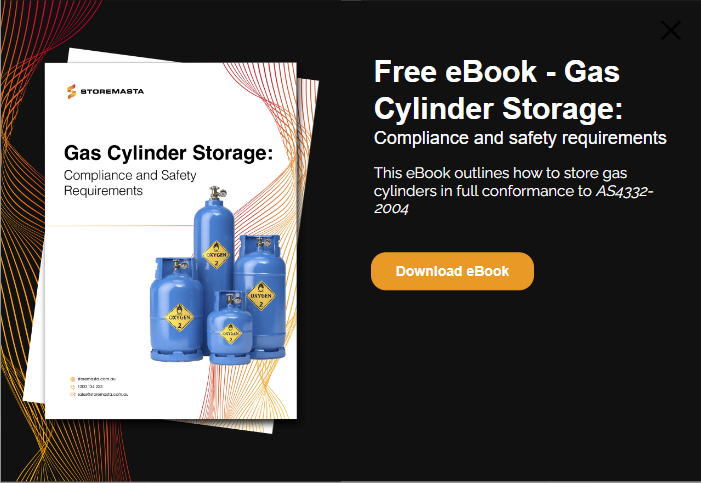As dangerous goods, compressed gases in cylinders must be stored and handled carefully to control risk. Here at Storemasta, we’ve developed our own risk management methodology, IDENTIFY - ASSESS - CONTROL – SUSTAIN, to ensure that every hazard associated with gas cylinders (as well as other dangerous goods) is managed correctly.
This post looks at the risk assessment process for compressed gas cylinders. We’ll take you step-by-step through the process and explain why this is essential for the safety and compliance of your worksite.
What is a Gas Cylinder Risk Assessment?
A risk assessment examines a series of workplace hazards and estimates the type of dangerous incidents or workplace accidents that could be triggered by the hazard.
For your onsite gas cylinders, the hazards may include exposure to toxic chemicals (toxic gases) fires or explosions (flammable gases) — or even manual handling injuries from staff carrying heavy cylinders.
The risk assessment for gas cylinders will then take a deeper dive to determine:
- The severity of the hazards (could anyone be killed? could the workplace be damaged? how about the environment?)
- How likely an accident or dangerous incident is to happen
- What is currently being done to control the risks?
- Which risks are the most urgent and require immediate action?
When dealing with a ‘known hazard’ there will always be associated ‘known control measures’ — these are well established and acceptable measures for meeting safety compliance. When known control measures are implemented, in some instances the full risk assessment process is not required by the WHS Act and Regulations.
IMPORTANT: The Safe Work Australia Code of Practice: How to manage work health and safety risks is an approved code of practice under Section 274 of the Work Health and Safety Act. Consult this code of practice to ensure your risk management methodology is up to standard.
Why You Should Conduct a Full Risk Assessment on Your Gas Cylinder Handling and Storage Areas
Gas cylinders present a complex range of hazards. Therefore, it’s important to conduct a full risk assessment of any handling and storage areas where gas cylinders are present.
The hazards posed by compressed gas cylinders are exacerbated by the combination of:
- Pressure (mechanical energy in a gas bottle is similar to a car travelling at 180km)
- Chemical properties of the gases (toxicology, flammability, stability)
- Physical nature of the gas cylinders (long slim design, heavy, bulky, slippery)
In many cases, it can be difficult to assess how the hazards could interact with one another to create new or greater risks.
For this reason, we at Storemasta recommend using a full risk management methodology to:
- Ensure that all gas cylinders hazards are identified
- Each hazard is thoroughly assessed
- Adequate control measures are introduced (based on the unique operational requirements of your worksite)
- Regular reviews are conducted on gas cylinders (and other dangerous goods) so that safety compliance is sustained
IMPORTANT: A risk assessment is mandatory under WHS Regulations for high-risk activities including: entry into confined spaces, diving work and live electrical work.
Storemasta Risk Management Methodology
The Storemasta risk management methodology was specifically designed in-house for workplaces and job sites carrying hazardous chemicals and dangerous goods.
Even though it consists of a simple 4-step process, it leaves nothing to guesswork or chance — ensuring that every hazard is identified and controlled.

Follow the steps that we’ve detailed to make sure that nothing is missed in your gas cylinder risk assessment.
STEP 1 - IDENTIFY The Hazards
Begin by identifying each of the gases, cylinder types and sizes, and where they are stored. Usually this is done in consultation with the staff who are handling the gases, as well as the suppliers who will provide Safety Data Sheets (SDSs) and valuable insights into other potential dangers.
When identifying hazards that gas cylinders pose, you should also consider:
- Chemical properties of the gases and what other dangerous goods, incompatible substances, materials, or equipment are present at the worksite
- Adequacy of job tasks, operating procedures, and staff training already in place
- Layout and design of the workplace
- Existing safety equipment, PPE and emergency management plans

Identifying the hazards with your compressed gas cylinders — and other dangerous goods — is the first step in your risk assessment.
STEP 2 - ASSESS The Risk To Workplace Safety
After identifying each cylinder hazard you should now consider the:
- Types of dangerous events that could be triggered by the hazards (decomposing acetylene cylinder = fire and explosion)
- Severity of the incidents (fatalities, destruction of property, damage to the environment)
- Likelihood of a dangerous event occurring (has it happened before? how many workers use acetylene? has everyone been suitably trained?)
Step 2 helps you prioritise the hazards so you begin controlling those most likely to happen and have the most critical consequences.
STEP 3 - CONTROL Measures Are Introduced To Minimise The Risks
In Step 3 of the risk management methodology, we apply each of the 5 elements of the Hierarchy of Control to all the hazards.

So, for every single gas cylinder hazard on your list you will consider:
- Elimination (could you stop using the gas altogether?)
- Substitution (could you use a gas that is less harmful?)
- Engineering (what changes to workplace design, gas cylinder storage or operating equipment could you install to minimise the harm?)
- Administration (what safe job methods and operating procedures could you introduce?)
- PPE (what personal protective equipment could be used by workers to prevent exposure to the gases?)
IMPORTANT: When working your way through the Hierarchy of Control, you must keep in mind that personal protective equipment merely puts a barrier between the worker and the hazard. Therefore, PPE should only be introduced alongside other control measures.
STEP 4 SUSTAIN - Compliance By Conducting Regular Reviews
Step 4 is key to ensuring that your workplace remains compliant. By conducting regular reviews to sustain compliance, you’ll be assessing the effectiveness of each of the control measures you introduced. You’ll also be identifying any new hazards introduced in the process.
Reviewing your controls, such as gas cylinder stores, will help you maintain chemical compliance and safety in your operations.
A clear example of this might be the decision to switch the warehouse forklifts over to diesel fuel instead of using LPG cylinders. Now the LPG cylinders have been substituted for another chemical, you’ll need to assess the impact of the diesel fuel on the workplace and the new hazards it may introduce.
Ultimately, the methodology operates in a circular fashion until each hazard is controlled — and safety compliance is achieved.
You’ll then implement regular reviews and follow up risk assessments, determined by changes at the worksite or as a direct response to an accident or near miss.
Gas Cylinder Safety
For more a more detailed look at the Storemasta risk management methodology — including guidelines for applying it to the gas cylinder risks and hazards at your own worksite — you can access our free eBook. Gas Cylinder Storage: Compliance and Safety Requirements explains the methodology using real world examples and case studies of workplaces that carry gas cylinders. Grab your copy today to learn more about gas cylinder risk assessments and safety.

Living life by the 4 C’s of marketing – communication, coffee, compliance… and more coffee – Leisa Andersen is Storemasta’s Content Marketing Manager. When she’s not writing, you’ll find her enjoying all the good things in life, including shopping, travel and gluten free donuts.

